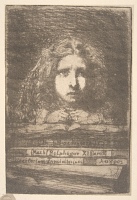Annie Haden with Books | ||
| Number: | 6 | |
| Date: | 1857/1858 | |
| Medium: | etching | |
| Size: | 97 x 65 mm | |
| Signed: | 'J. W.' in reverse at right | |
| Inscribed: | no | |
| Set/Publication: | no | |
| No. of States: | 1 | |
| Known impressions: | 1 | |
| Catalogues: | K.8; M.10; T.-; W.2 | |
| Impressions taken from this plate (1) | ||
KEYWORD
book, girl, portrait, reading.
TITLE
There are only two variations on the title:
'Annie Haden' (1870s, Whistler). 3
'Annie Haden' (1886, Frederick Wedmore (1844-1921)). 4
'Annie Haden with Books' (1909, Howard Mansfield (1849-1938)). 5
Although Whistler identified this as 'Annie Haden', Mansfield gave it the fuller, descriptive title, Annie Haden with Books to distinguish it from other portraits of the same sitter, such as Annie [7], Annie, Seated [32], and Annie Haden [67].
'Annie Haden' (1870s, Whistler). 3
'Annie Haden' (1886, Frederick Wedmore (1844-1921)). 4
'Annie Haden with Books' (1909, Howard Mansfield (1849-1938)). 5
Although Whistler identified this as 'Annie Haden', Mansfield gave it the fuller, descriptive title, Annie Haden with Books to distinguish it from other portraits of the same sitter, such as Annie [7], Annie, Seated [32], and Annie Haden [67].
DESCRIPTION
The head and shoulders of a plump-faced young girl with long wavy hair, who is leaning on a pile of books looking at the viewer. Her clasped hands rest on the topmost book, which is open. Whistler's signature, 'J.W.' appears in reverse on the open book, at right. The books bear the titles, 'DSwedenborgo', 'Mach (Belphegor XII) iavelli', 'Directorium Inquisitorium', and the Greek letters 'Ëïãïò' ('logos', meaning oration, reason, speech, word). 6
6: Mansfield 1909 (cat. no. 10) described the titles slightly incorrectly, as 'Swedenborg', 'Machiavelli', 'Belphegor XII', 'Directorium Inquisitorium'.
SITTER
Annie Harriet Haden (1848-1937). This study was probably done at the same time as the portrait of her brother, Seymour, Standing [10], although the format differs considerably. Later portraits include Annie [7] (which is reproduced below), Annie, Seated [32], and Annie Haden [67].
DISCUSSION
The volumes represent various approaches to Christianity. Nicholas Eymeric's handbook Directorium inquisitorium was published in 1376 as a guide for Inquisitors, and reissued many times in later centuries. Niccoló Machiavelli (1469-1527) wrote L'archidiable Belphégor, a satirical novel about marriage, concerning a demon who, after many tribulations, returns to hell to escape his wife. Emanuel Swedenborg (1688-1772) was a Swedish scientist, Christian mystic, philosopher and theologian, whose famous publication, De Caelo et Ejus Mirabilibus et de inferno, ex Auditis et Visis ('Heaven and its Wonders and Hell From Things Heard and Seen', 1758), was a result of personal dreams and visions about the afterlife. Finally, the Greek word 'logos' might be interpreted as meaning 'word' or 'wisdom', or refer to a more specific volume of speeches. In the context of Christian theology, 'Logos' is used in the Gospel of John to describe Christ, 'the Word became flesh' (John 1.14).
Lochnan interprets the etching as a caricature: 'One is given the impression that she is being forced to absorb a great deal of meaningless rubbish of a kind which her sympathetic uncle had done his best to avoid.' 7
7: Lochnan 1984, pp. 25-26.
It is perfectly true that many of Whistler's earlier drawings contain a strong element of caricature. However, his juvenile work also included a range of religious, romantic and mystic subjects, and some literary themes, such as the story of Faust, continued to interest him well into the 1870s. 8 It is possible that here the young artist was exploring a literary subject, or fantasy arising from literature, and that his little niece helped him by acting as a character in a story. It is worth noting that the title page of a journal started by Whistler in 1855 showed a Monk writing. 9 So although the books under Annie's hands appear to represent obscure branches of learning, it may be that they were books that held a particular interest for Whistler and for his circle.
8: For instance, Lady with a lantern [m0086], r.: Demon; v.: Two sketches of Nellie Farren [m0666].
9: 'Nulla dies sine linea': (a) Monk writing; (b) An old man in a nightcap reading; (c) Whistler changing clothes with a 'Pleb' [m0193].
Lochnan compares the handling of the slightly over-large head and small hands with the illustrations of Hablot K. Browne (1815-1882), etcher and chief illustrator ('Phiz') to Dickens's writings at this period, including Little Dorrit (1857), as well as illustrator of Charles Lever's Davenport Dunn (1857-1859). Other influences include illustrators and caricaturists like John Leech (1817-1864), and John Tenniel (1820-1914). Coincidentally, Tenniel's later illustrations for Lewis Carroll's (Charles Lutwidge Dodgson) Alice in Wonderland (1865), show Alice with an oversize head and small hands, comparable in proportion to Whistler's earlier etching.


